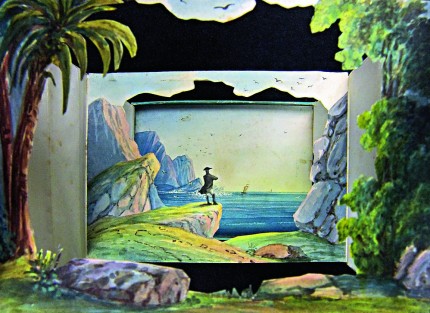
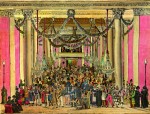 The collection of more than 360 peepshows was given to the nation by collectors Jacqueline and Jonathan Gestetner under the Cultural Gifts Scheme which allows UK taxpayers to donate artworks or other objects of important cultural patrimony. In return, donors get a tax deduction in the amount of a set percentage of the object’s value. An advisory panel then recommends which institution should receive the donated item.
The collection of more than 360 peepshows was given to the nation by collectors Jacqueline and Jonathan Gestetner under the Cultural Gifts Scheme which allows UK taxpayers to donate artworks or other objects of important cultural patrimony. In return, donors get a tax deduction in the amount of a set percentage of the object’s value. An advisory panel then recommends which institution should receive the donated item.
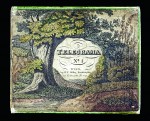 The Gestetner collection covers the full history of the paper peepshow from the earliest examples in the 1820s to the present day. The oldest piece in the collection is called Teleorama No. 1 and was made in Austria by Heinrich Friedrich Müller around 1824-25. Müller was a pioneer in the printing of high quality picture books for children. He rejected the more rudimentary style of illustration prevalent in the children’s books of the time, and starting in 1811, turned to master artists, engravers, colorists and painters to create lesson books, educational workbooks, texts and readers with beautiful color illustrations.
The Gestetner collection covers the full history of the paper peepshow from the earliest examples in the 1820s to the present day. The oldest piece in the collection is called Teleorama No. 1 and was made in Austria by Heinrich Friedrich Müller around 1824-25. Müller was a pioneer in the printing of high quality picture books for children. He rejected the more rudimentary style of illustration prevalent in the children’s books of the time, and starting in 1811, turned to master artists, engravers, colorists and painters to create lesson books, educational workbooks, texts and readers with beautiful color illustrations.
His picture books were massively successful and other printers fell all over themselves to copy him. Meanwhile Müller kept it moving, expanding his business to other fine color-printed products including board games, embroidery panels and peepshows. The peepshows captured the consumer imagination swell, first in Austria and Germany, then outwards to northern Europe and Britain. Thousands of the detailed depictions of idyllic exteriors and luxurious interiors were bought by foreign buyers.
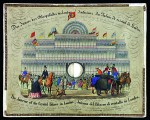 British printers got on the bandwagon and peepshows celebrating momentous national events or the latest marvel of the Victorian era soon became popular souvenirs. The Thames Tunnel and Crystal Palace were particularly popular subjects, if the Gestetner collection is any proof. There are more than 60 peepshows on those two wonders of the age.
British printers got on the bandwagon and peepshows celebrating momentous national events or the latest marvel of the Victorian era soon became popular souvenirs. The Thames Tunnel and Crystal Palace were particularly popular subjects, if the Gestetner collection is any proof. There are more than 60 peepshows on those two wonders of the age.
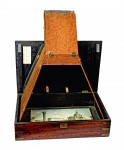 Some of the related optical artifacts in the collection predate the peepshows. The oldest object beats Mr. Müller’s work by almost a century. It’s a boîte d’optique of British manufacture, made ca. 1740, a precursor to the peepshow. It’s a mahogany box with a lens. A print of something exotic would be placed in the box and viewers would pay to see the subject in full-screen.
Some of the related optical artifacts in the collection predate the peepshows. The oldest object beats Mr. Müller’s work by almost a century. It’s a boîte d’optique of British manufacture, made ca. 1740, a precursor to the peepshow. It’s a mahogany box with a lens. A print of something exotic would be placed in the box and viewers would pay to see the subject in full-screen.
The range of sizes is enormous. The longest peepshow wasn’t the work of a professional printer. 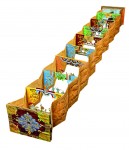 It was handmade and handpainted in around 1910 and depicts riflemen on manoeuvre over nine panels that when stretched all the way is more than 6.5 feet long. The smallest is an Italian work from ca. 1900. L’Onomastico (“The Name Day”) is tiny, just the size of a small matchbox, but it holds large wonders. When stretched all the way out, it’s almost eight inches long and depicts the revelries of a name-day street party.
It was handmade and handpainted in around 1910 and depicts riflemen on manoeuvre over nine panels that when stretched all the way is more than 6.5 feet long. The smallest is an Italian work from ca. 1900. L’Onomastico (“The Name Day”) is tiny, just the size of a small matchbox, but it holds large wonders. When stretched all the way out, it’s almost eight inches long and depicts the revelries of a name-day street party.
Dr Catherine Yvard, Special Collections Curator at the National Art Library, on the V&A’s new baby:
“This collection is a real treasure trove and makes a wonderful addition to our holdings, which focus particularly on the art of the book. Peeping into one of these tunnel-books is like stepping into another world, travelling through time and space. In an instant you can join Napoleon on the Island of St Helena or a rowdy masquerade on London’s Haymarket. Peepshows were 19th century virtual reality. They offer wonderful insights into social history. Considering that most of them would have been made quite cheaply, it is a miracle that so many have survived.”
For now the peepshows can only be viewed in person by appointment at the Victoria & Albert’s National Art Library. They will soon be digitized and available to search both in the National Art Library Catalogue and in the V&A collection database.
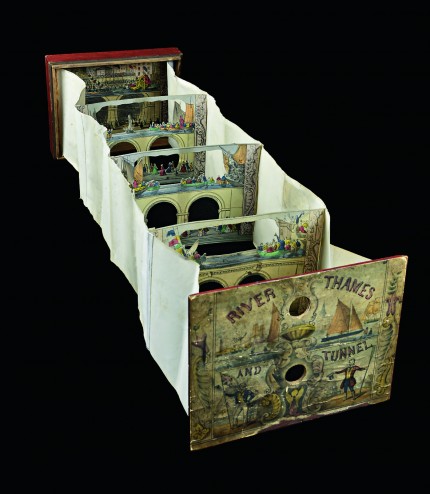
NB: All of the objects pictured in this post were accepted under the Cultural Gifts Scheme by HM Government from the collections of Jacqueline Gestetner and Jonathan Gestetner and allocated to the Victoria and Albert Museum, 2016.